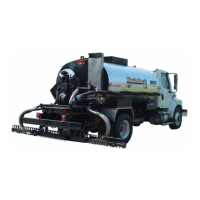7
Rosco Maximizer 3B Asphalt Distributor 7-13
Maintenance
4. Change the oil in the reservoir annually or every
400 hours, whichever comes rst. The drain plug
is located in the bottom of the tank. Drain the oil
when the system is warm or hot to remove the most
contaminants. DO NOT SMOKE when working
around hot oil. Use a large pail or container to
collect the used oil. Dispose of the used oil in an
approved manner. Refer to Table 7-2. Hydraulic
Fluids Chart for recommended grades and
manufacturers. Watch the sight gauge.
NOTE: Contaminants can enter the system when
hydraulic cylinder rods are retracted. The asphalt
can get past the seals and can be dissolved
by the oil. Changing the oil will remove these
contaminants and prevent gum deposits from
building up on the internal components.
5. The hydraulic system is equipped with an oil lter to
remove dirt and other contaminants. Change the oil
lter if the pointer is in the red position. To check the
condition of the oil lter or change it:
a. Start the engine.
b. Engage PTO (if equipped) to operate the
hydraulic system.
c. Run the engine at 1200 RPM.
d. Visually check the pointer on the gauge at the
top of the lter. If the pointer is not in the red area,
the lter does not need to be changed.
e. Change the oil lter after 400 hours or
annually.
The pointer indicates the pressure
drop across the lter. This can only give an accurate
reading when oil is circulating through the system.
Hydraulic System
Hydraulic power is used to drive the asphalt pump,
raise, and move the spraybar. A direct connection to the
engine or a PTO drive from the transmission is used to
power a variable displacement piston pump which in
turn drives the asphalt pump and auxiliary functions. The
hydraulic motor powering the asphalt pump is a xed
displacement high torque low speed motor. To service
and maintain the system, follow this procedure:
Always wear protective clothing,
gloves and a face shield. Hydraulic uid under
pressure can penetrate skin and cause serious
injury.
DO NOT SMOKE around the machine.
Fuel, asphalt material and the fumes from either
can explode when exposed to ame or heat from
smoking or other sources.
1. The hydraulic reservoir is located on the left side
of the vehicle. Check the sight gauge at the start
of each working day. The oil level should be at the
center of the sight glass to allow room for expansion
as the oil warms during operation.
2. Add oil through the ller cap on the side of the tank.
Clean the cap and ller neck before lling to be
sure that no dirt or contaminants enter the tank.
Hydrostatic systems will fail in a short time if the oil
is not clean. Watch the sight glass when adding oil.
Add until the oil level is in the center of the gauge.
3. The reservoir has a temperature switch that is set
at 210° F (99° C). The sight gauge also displays
the hydraulic oil temperature. Check the sight
gauge if the control panel hydraulic temperature
indicator comes on. Check the temperature to
assure operating temperature is below 225° F
(107° C). If the temperature exceeds 225° F (107°
C), check the system for a failing motor or pump
(see Troubleshooting in Section 8). Keep the tank
exterior clean to maximize heat dissipation which
will help cool the oil in the system.
Return to
Last Viewed
Return to
Thumb Index

